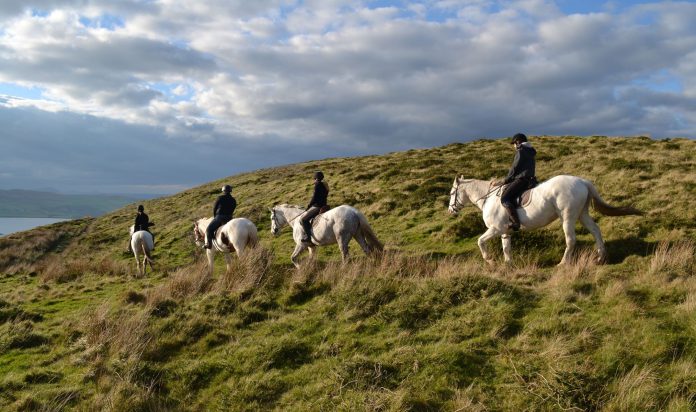Horses are known to be the best companion of humans, people have also claimed them to be the loyal animal, but what goes inside them is only what an expert can unveil. And Terri Jay is the perfect person to enhance a lay man’s knowledge on what goes inside our horses’ mind. In a detailed conversation with La Polo, Terri Jay, a professional.
THE POWER OF TELEPATHY
All animals, including human beings, are telepathic. Horses use telepathy or mind-to-mind communication with each other. Humans are born that way but turn it off in childhood. In order to communicate with horses, the same way that they communicate with each other, we need to turn on our telepathic instincts. Horses communicate with visual images, feelings (emotions or pain), smell, taste and sound. We need to learn to listen in a different way. We need to listen better too so as not to mis any clue. Some people call this horse whispering, since there is nothing visual or auditory going on during the communication.
It is a true mind-to-mind conversation. From physics, we know, that everything is energy and everything has a vibration and frequency. So, you may communicate from a distance too. I have done readings on horses all over the world by connecting to the horse through the owner. Unconditional love is the most powerful energy in the Universe. I give my clients unconditional love and when they start talking about their horses, I can feel the horse through them.
UNDERSTANDING THE HORSE
Horse graze and run from predators. They are not designed to be ridden, carry weight or ram-and-jam with us on their backs. But they love their jobs. You cannot make a horse do anything it doesn’t want to. They must have saddles that fit which should be checked often, since the horses’ backs change all the time. If we don’t maintain regularly, horse may have excruciating pain. Pain leads to behaviour problems. I am willing to state that 99% of all horse behaviour problems are “undiagnosed pain issues”. The other 1% may be fear. Most performance riders understand this. They can feel when something is off and they seek professional advice to address the pain. When a horse is in pain, it may become dangerous. It is critical to learn to listen to your horse and not judge it. Find the source of the pain and address it.

TEAM WORK
When players know and understand that the horse is telepathic, they may consciously send information to the horse and rely less on reins and leg cues. If the player can visualize where and how they want the horse to move, the horse can pick up on such thoughts and feelings.
WHAT IS VETERINARY INTUITION?
Veterinary intuition is feeling into a horse energetically to search for pain, disease or more. We can determine pain levels and locations, ulcers (which are common), cause of lameness, bleeders, EPM loads, parasite infestations, colic, kidney stones, ticks in ears, teeth problems, TMJ, female problems, farrier issues, and more.

READING ON HORSES
I love doing readings on horses. They are among my favourite types of readings. With horses, the only way they have of letting us know that they have pain is to exhibit naughty behaviour. If their behaviour gets better, we may assume that our intervention has been fruitful. They strike, buck, bolt, kick, bite, refuse, fail to pick up leads at the canter and more, due to pain. The only other reason they may exhibit such behaviours is fear, and most horse people understand the difference.
OBESITY: A RED FLAG
Horses are natural grazers. In many cases, horses are stalled for convenience, and we give them concentrated feeds such as baled hay, extruded (pelletized) feeds, grains, and the treats. When we stall a horse and take away their need to graze, by dumping food in front of them, they are not burning calories that they would in the wild, or at a pasture while grazing. When we reduce their work, we must reduce their caloric intake. The amount of feed a horse should consume should be based on calories they are going to burn. Race horses, polo horses, barrel racing horses, hunter jumpers, dressage horses, rope horses and horses that work cattle all day, need more concentrated calories than a backyard horse that goes for a trail ride a couple of times a week. Often horses can be determined to be Insulin Resistant, which is a metabolic disorder and can predispose them to Cushing’s which is also a metabolic disorder. Low sugar and low starch diets are essential for horses with these conditions. Thyroid levels should be tested on chubby horses to determine if that is a contributing factor. All of these are treatable, if diagnosed timely. The worst result from obesity in horses is laminitis which is an inflammation of the hooves. It is incredibly painful. If it gets bad enough, it may lead to the horse needing to be euthanized.
DARK REALITY OF HORSE INDUSTRY
Horses being thrown away is very common. Sadly, the biggest contributor to the horse-meat industry is the horse racing industry. In the US, there are no horse slaughter plants. So horses that are purchased by kill buyers get shipped to Canada or Mexico for processing. They are shipped for days with no food and water, and often become severely injured. This causes incredible stress to them. There are organizations that outbid the kill buyers to save some of the horses destined for slaughter. These rescue groups raise money to bid for horses, rehabilitate them and find adopters to give them good homes.

THERAPEUTIC HORSES
I have operated a therapeutic riding program, off and on for about 35 years. We had kids that couldn’t walk and take their first steps after riding. We had autistic kids say their first word which was NO, when it was time to get off the horse. Horses are telepathic as we know and many disabled kids are telepathic too, so the horses and such kids have good conversations. An old expression is that the outside of a horse is good for the inside of a person. Nowhere is this truer than in horseback therapy programs.





